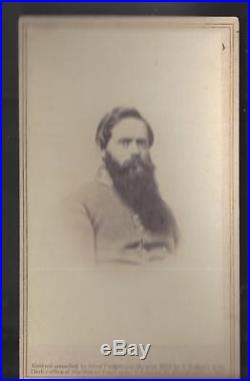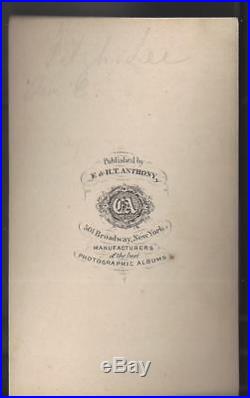Civil War CDV, Confederate General Fitzhugh Lee



Fitzhugh Lee (November 19, 1835 April 28, 1905) was a Confederate cavalry general in the American Civil War, the 40th Governor of Virginia, diplomat, and United States Army general in theishAmerican War. He was the son of Sydney Smith Lee, a captain in the Confederate States Navy, and the nephew of General Robert E. Lee was born at Clermont in Fairfax County, Virginia.
He was the grandson of "Light Horse Harry" Lee, a nephew of Robert E. Lee and Samuel Cooper, and cousin of George Washington Custis Lee, W. "Rooney" Lee, and Robert E. [1] His father, Sydney Smith Lee, [2] served under Commodore Perry in Japanese waters and rose to the rank of Captain; his mother, Anna Maria Mason Lee, was a granddaughter of George Mason and the sister of James Murray Mason.Graduating from the United States Military Academy in 1856, Lee was commissioned a second lieutenant in the 2nd Cavalry Regiment (later redesignated the 5th Cavalry Regiment), which was commanded by Colonel Albert Sidney Johnston, and in which his uncle, Robert E. As a cavalry subaltern, he distinguished himself by his gallant conduct in actions against the Comanches in Texas, and was severely wounded in a fight in Nescutunga, Texas, in 1859. [4] In May 1860, he was appointed instructor of cavalry tactics at West Point, but resigned his commission upon the secession of Virginia.
Lee joined the Confederate States Army as a lieutenant of cavalry and served at first as a staff officer to Brig. Ewell at the First Battle of Bull Run.
He was promoted to lieutenant colonel of the 1st Virginia Cavalry in September 1861, serving under Colonel J. Lee became colonel of the regiment in March 1862 and was promoted to brigadier general on July 24, 1862. During the Northern Virginia Campaign, Lee received notoriety by arriving late for a concentration of cavalry, which allowed Federal cavalry to raid Stuart's headquarters and capture his famous plumed hat and cape.
However, during the subsequent Confederate raid on Catlett's Station, he captured the headquarters tent and dress uniform of Union Maj. Lee gave Pope's coat to Stuart as compensation for the hat he had lost. Lee performed well in the Maryland Campaign of 1862, covering the Confederate infantry's withdrawal from South Mountain, delaying the Union Army advance to Sharpsburg, Maryland, before the Battle of Antietam, and covering his army's recrossing of the Potomac River into Virginia. He conducted the cavalry action of Kelly's Ford (March 17, 1863) with skill and success, where his 400 troopers captured 150 men and horses with a loss of only 14 men. In the Battle of Chancellorsville in May 1863, Lee's reconnaissance found that the Union Army's right flank was "in the air", which allowed the successful flanking attack by Maj. "Stonewall" Jackson, a movement led by Lee's cavalry.After Chancellorsville, Lee was incapacitated by inflammatory rheumatism, missing a month of action, which included the significant cavalry operations at the Battle of Brandy Station. He recovered in time to lead a brigade in Jeb Stuart's ride around the Union Army in the early days of the Gettysburg Campaign, with his most significant contribution being at the Battle of Carlisle.
During the Battle of Gettysburg, his brigade fought unsuccessfully in the action at East Cavalry Field. Stuart's report singled out no officer in his command for praise except Fitz Lee, who he said was one of the finest cavalry leaders on the continent, and richly [entitled] to promotion.
[5] Lee was promoted to major general on August 3, 1863. In the Overland and Petersburg campaigns of 1864, he was constantly employed as a divisional commander under Stuart, and, after Stuart's death, under Maj. Hampton, who had been Lee's peer for much of the war, was promoted to replace Stuart due to his seniority and greater level of experience; some observers at the time had cynically expected Robert E. Lee's nephew to receive the command. Despite Lee's abilities, in 1864 he was unable to break through United States Colored Troops defense of Fort Pocohontas in Charles City County. Lee took part in Lt. Early's campaign against Maj.Philip Sheridan in the Shenandoah Valley, and at Third Winchester (September 19, 1864) three horses were shot under him and he was severely wounded. [4] When General Hampton was sent to assist General Joseph E. Johnston in North Carolina, the command of the whole of Robert E. Lee's cavalry devolved upon Fitzhugh Lee on March 29, 1865, but the surrender at Appomattox followed quickly upon the opening of the campaign. Fitzhugh Lee himself led the last charge of the Confederates on April 9 that year at Farmville, Virginia.
The item "Civil War CDV, Confederate General Fitzhugh Lee" is in sale since Saturday, December 16, 2017. This item is in the category "Collectibles\Militaria\Civil War (1861-65)\Original Period Items\Photographs".
The seller is "civil_war_photos" and is located in Midland, Michigan. This item can be shipped worldwide.